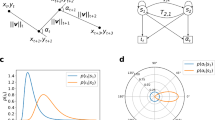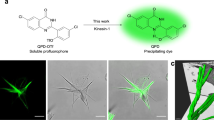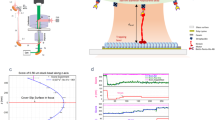Abstract
We have developed an optical trapping method to precisely measure the force generated by motor proteins on single organelles of unknown size in cell extract. This approach, termed VMatch, permits the functional interrogation of native motor complexes. We apply VMatch to measure the force, number and activity of kinesin-1 on motile lipid droplets isolated from the liver of normally fed and food-deprived rats.
This is a preview of subscription content, access via your institution
Access options
Subscribe to this journal
Receive 12 print issues and online access
$259.00 per year
only $21.58 per issue
Buy this article
- Purchase on Springer Link
- Instant access to full article PDF
Prices may be subject to local taxes which are calculated during checkout


Similar content being viewed by others
References
Vale, R.D. Cell 112, 467–480 (2003).
Neuman, K.C. & Block, S.M. Rev. Sci. Instrum. 75, 2787–2809 (2004).
Rice, S.E., Purcell, T.J. & Spudich, J.A. Methods Enzymol. 361, 112–133 (2003).
Welte, M.A. et al. Cell 92, 547–557 (1998).
Shubeita, G.T. et al. Cell 135, 1098–1107 (2008).
Sims, P.A. & Xie, X.S. ChemPhysChem 10, 1511–1516 (2009).
Leidel, C. et al. Biophys. J. 103, 492–500 (2012).
Soppina, V. et al. Proc. Natl. Acad. Sci. USA 106, 19381–19386 (2009).
Rogers, S.L. et al. Proc. Natl. Acad. Sci. USA 94, 3720–3725 (1997).
Vershinin, M. et al. Proc. Natl. Acad. Sci. USA 104, 87–92 (2007).
Gibbons, G.F. et al. Biochem. Soc. Trans. 32, 59–64 (2004).
Welte, M.A. Biochem. Soc. Trans. 37, 991–996 (2009).
Takahashi, K. et al. J. Lipid Res. 51, 2571–2580 (2010).
Vermeulen, K.C. et al. Rev. Sci. Instrum. 77, 13704–13709 (2006).
Tolic-Nørrelykke, S.F. et al. Rev. Sci. Instrum. 77, 103101–103111 (2006).
Staforelli, J.P. et al. Opt. Express 18, 3322–3331 (2010).
Soppina, V., Arpan, R. & Mallik, R. Biotechniques 46, 543–549 (2009).
Carter, B.C., Shubeita, G.T. & Gross, S.P. Phys. Biol. 2, 60–72 (2005).
Mallik, R. et al. Nature 427, 649–659 (2004).
Mallik, R. et al. Curr. Biol. 15, 2075–2085 (2005).
Brasaemle, D.L. & Wolins, N.E. Curr. Protoc. Cell Biol. 56, 3.15 (2006).
Ontko, J.A., Perrin, L.W. & Horne, L.S. J. Lipid Res. 27, 1097–1103 (1986).
Brasaemle, D.L. et al. J. Biol. Chem. 279, 46835–46842 (2004).
Wang, H. et al. Mol. Biol. Cell 21, 1991–2000 (2010).
Castoldi, M. & Popov, A.V. Protein Expr. Purif. 32, 83–88 (2003).
Schroer, T.A. & Sheetz, M.P. J. Cell Biol. 115, 1309–1318 (1991).
Kaan, H.Y., Hackney, D.D. & Kozielski, F. Science 333, 883–885 (2011).
Acknowledgements
We thank A. Rai and R. Jha for discussions and help and K. Verhey (University of Michigan) for kinesin-1 antibody. R.M. acknowledges funding through an International Senior Research Fellowship from the Wellcome Trust, UK (grant WT079214MA).
Author information
Authors and Affiliations
Contributions
R.M. designed the experiments. P.B., A.R., P.R. and R.M. performed the experiments. R.M., P.B. and A.R. analyzed the data and wrote the paper.
Corresponding author
Ethics declarations
Competing interests
The authors declare no competing financial interests.
Supplementary information
Supplementary Text and Figures
Supplementary Figures 1–5 and Supplementary Notes 1–3 (PDF 928 kb)
The microtubule is out of focus and therefore not visible clearly.
The lipid droplet moves towards microtubule plus end. The microtubule minus end was labeled using avidin coated magnetic beads (not visible in this field of view). Movie runs in real-time. Field of view is 10 microns horizontally. (AVI 884 kb)
The polarity label on minus-end of microtubule is not visible in this field of view.
Movie runs in real-time. Field of view is 5 microns horizontally. (AVI 2002 kb)
Rights and permissions
About this article
Cite this article
Barak, P., Rai, A., Rai, P. et al. Quantitative optical trapping on single organelles in cell extract. Nat Methods 10, 68–70 (2013). https://doi.org/10.1038/nmeth.2287
Received:
Accepted:
Published:
Issue Date:
DOI: https://doi.org/10.1038/nmeth.2287
This article is cited by
-
Complete chloroplast genomes of two medicinal Swertia species: the comparative evolutionary analysis of Swertia genus in the Gentianaceae family
Planta (2022)
-
From physics to physiology at the membrane–motor interface
Nature Reviews Molecular Cell Biology (2020)
-
Probing force in living cells with optical tweezers: from single-molecule mechanics to cell mechanotransduction
Biophysical Reviews (2019)
-
Calibration of force detection for arbitrarily shaped particles in optical tweezers
Scientific Reports (2018)
-
Load-induced enhancement of Dynein force production by LIS1–NudE in vivo and in vitro
Nature Communications (2016)



